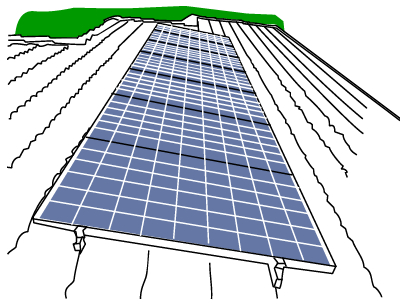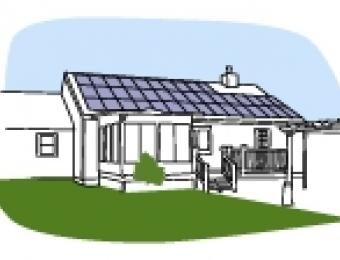
What are photovoltaic solar panels?
A solar panel converts light energy from the sun in the form of photons into an electrical current using photovoltaics (‘photo’ meaning ‘light’ and ‘voltaic’ meaning ‘electricity’). Solar panels works by absorbing light into a silicon, which is a semiconductor. Solar panels are linked together to form an array, which combines the generated electricity and channels it into an inverter where it's converted to a suitable voltage.
How do solar panels work?
The photovoltaic effect works on a molecular level. The silicon panel consists of two layers; a positively charged layer and a negatively charged layer (or 'p' and 'n' layers). A photon is a packet of energy and a constituent particle of light. When a photon from the sun hits the surface of the solar panel, it's absorbed by the silicon and knocks loose an electron. The electron is drawn towards one side by the differently charged layers, where it comes into contact with a metal grid. This process generates a direct current (DC) of electricity which is collected and converted to alternating current (AC) electricity for use in the home.
How are solar panels installed?
Working at heights and with electricity are both extremely dangerous if you're not properly trained to do so.
Solar panels are best faced towards the north on an approximate 30º incline. The roof's often the ideal spot for them, because it's likely to get less shade than any other part of your property. If you are installing solar panels on your roof, you'll also need to ensure that your roof's designed to be able to take the extra load. Where possible, it’s best to have any support structures for the panels attached directly to the frame of the house for maximum stability.
Solar panels can also be installed using a ground-based array, or as a pergola roof (among other choices).
Types of solar cells
There are four main types of solar cell currently on the market:
- Single or mono crystalline solar cells. These cells are made of single slices of highly pure silicon crystal which are laid flat and connected like tiles. These cells have some of the highest efficiency ratings for individual cells at around 12-17% light conversion - but due to the necessary layout, they end up having around the same efficiency as poly crystalline panels.
- Multiple or poly crystalline solar cells. These cells are made from slightly less pure silicon crystals which are cast into blocks and then cut to size resulting in a less efficient cell, around 11-14%. Because the cells can be joined more closely together though, the reactive surface area of a panel is increased, boosting efficiency to similar levels as single crystal cells.
- String ribbon solar cells. This is a more energy efficient way of preparing silicon. Two metal strings are dragged through molten silicon, creating a ribbon which can be laid directly into the panel. These are less efficient at around 12-13%, which means panels have to be larger to generate the same power output.
- Thin film or amorphous solar cells. This term covers a number of different preparations for extremely thin layers of solar cells. The resultant efficiency is not great at around 8-10%, which means panels have to be twice as large to generate the same power output, but there is a lot of research being poured into this area including flexible panels, micro cells and ‘liquid’ cells so the potential for whole new breeds of solar energy collection is getting higher every day.
What to look for in solar panels
There are a few different things you should consider when you're choosing between solar panels. These include:
- Efficiency to price. Higher efficiency usually means more cost, so you’ll need to offset the outlay against the potential for energy generation over time.
- Efficiency to available space. If you have limited space on your roof, a high efficiency panel can be smaller and still produce the same energy output as a much larger low efficiency panel.
- Warranties and Standards. Always look for a long warranty and confirm the product meets Australian Standards.
As with anything else, make sure you read the fine print and know exactly what you are (and aren't) paying for!





